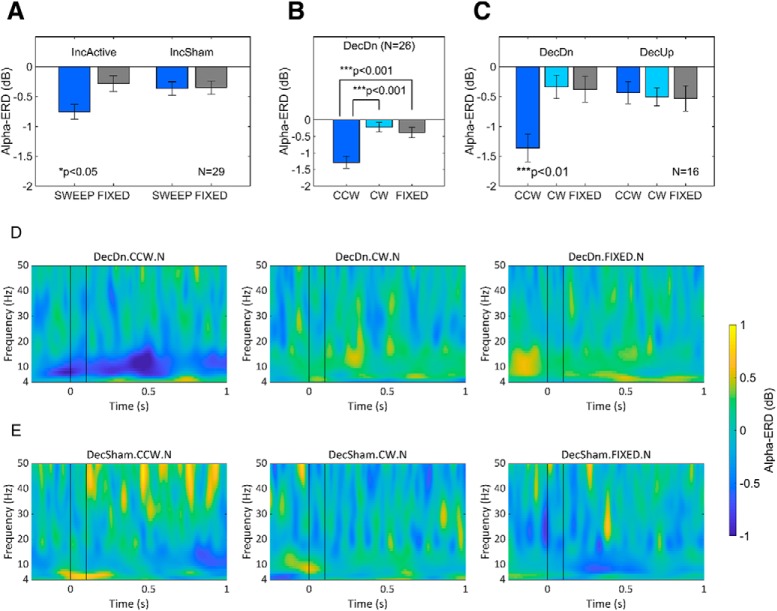Figure 6.
Group results from repeated-measures ANOVA for the effects of geomagnetic stimulation on post-stimulus alpha-power. A, Average alpha-ERD (dB) at electrode Fz in the SWEEP and FIXED conditions of inclination experiments run in active or sham mode. Two-way ANOVA showed an interaction (p < 0.05, N = 29) of inclination rotation (SWEEP vs FIXED) and magnetic stimulation (active vs sham). According to post hoc testing, only inclination sweeps in active mode produced alpha-ERD above background fluctuations in FIXED trials (p < 0.01) or sham mode (p < 0.05). B, Average alpha-ERD (dB) at electrode Fz in the declination experiment with inclination held downwards (DecDn). One-way ANOVA showed a significant main effect of declination rotation (p < 0.001, N = 26). The downwards-directed counterclockwise rotation (DecDn.CCW.N) produced significantly different effects from both the corresponding clockwise rotation (DecDn.CW.N, p < 0.001) and the FIXED control condition (DecDn.FIXED.N, p < 0.001). C, Comparison of the declination rotations with inclination held downwards (DecDn) or upwards (DecUp) in a subset (N = 16 of 26) of participants run in both experiments. Two-way ANOVA showed a significant interaction (p < 0.01) of declination rotation (CCW vs CW vs FIXED) and inclination direction (Dn vs Up). Post hoc testing showed significant differences (p < 0.01) between the DecDn.CCW.N condition and every other condition, none of which were distinct from any other. This is a direct test and rejection of the quantum compass hypothesis. D, Grand average of time-frequency power changes across the 26 participants in the DecDn experiment from B. Black vertical lines indicate the 0- to 100-ms field rotation interval. A post-stimulus drop in alpha-power was observed only following the downwards-directed counterclockwise rotation (left panel). Wider spread of desynchronization reflects interindividual variation. Convolution involved in time/frequency analyses causes the early responses of a few participants to appear spread into the pre-stimulus interval. E, Grand average of time-frequency power changes across the 18 participants with sham data in the declination experiments; no significant power changes were observed.

